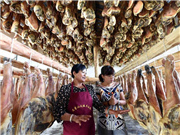

3) The service sector sustained rapid growth.
New business types and models displayed robust development. Cultural and creative industries and design services were further integrated with related industries, and a mid-to-long-term development plan and three-year action plan were introduced for the logistics industry. The value-added of tertiary industry (the service sector) amounted to 30.7 trillion yuan, increasing by 8.1% over the previous year and accounting for 48.2% of the GDP, 5.6 percentage points higher than that of secondary industry.
4) Basic industries and infrastructure developed quickly.
The country’s comprehensive transportation system was further improved, with the total length of railway lines and expressways open to traffic both exceeding 110,000 kilometers. National internet backbone access points were built in seven more cities, and fiber optic broadband was made available to another 30 million households or so. The installed capacity of hydropower facilities nationwide exceeded 300 million kilowatts. Major progress was made in the exploration and exploitation of coal seam gas, shale gas, and deep-water oil and gas. Construction began on 57 of 172 major water conservancy projects that have been planned. The first phase of the central route of the South-to-North Water Diversion Project was put into operation, providing drinking water from the Yangtze River to 60 million residents in the Beijing-Tianjin-Hebei region.
4. We bolstered the foundations of agricultural and rural development and made advances toward balanced development between urban and rural areas and between regions.
Throughout the year we vigorously developed modern agriculture, steadily promoted a new type of people-centered urbanization, optimized the spatial planning of economic development, and took new steps in balancing development between urban and rural areas and between different regions.
1) Agriculture and rural areas showed good development momentum.
Investment related to agriculture, rural areas, and farmers was further increased, and the development of agricultural infrastructure was supported. We oversaw the orderly transfer of land operation rights, leading to the transfer of around 30% of contracted land-use rights in rural areas. We formulated an overall plan to control serious agricultural environmental pollution, guidelines on establishing demonstration zones for ecological conservation and improvement, a plan to reform state forestry farms, and guidelines on reforming state forestry areas. Total grain output grew for the 11th consecutive year, reaching 607 million metric tons. Production of agricultural and sideline products, including meat, eggs, milk, fruit, vegetables, and fish, remained stable. We guaranteed the provision of safe drinking water for over 66 million more rural residents, renovated dilapidated houses for 2.66 million rural households, and reduced the number of rural population living in poverty by 12.32 million.
2) A new type of urbanization was advanced in an active yet prudent way.
We issued and implemented a national plan on a new type of urbanization, and carried out supporting policies such as a plan to reform the household registration system and a scheme for fulfilling the three tasks, each concerning 100 million people: granting urban residency to around 100 million people who have moved to cities from rural areas, rebuilding run-down areas and “villages” inside cities where around 100 million people live, and guiding the process of urbanization of around 100 million rural residents in the central and western regions. Comprehensive trials for a new type of urbanization were launched in two provinces and 62 cities or towns. Standards for classifying cities based on their population were fine-tuned. The percentage of the population residing permanently in urban areas was 54.77%. The percentage of the population registered as permanent urban residents is estimated to have reached 36.7%.
 |  |
Day|Week

 Tsinghua junior makes over 10,000 yuan a day by selling alumnae's used quilts
Tsinghua junior makes over 10,000 yuan a day by selling alumnae's used quilts Graduation photos of students from Zhongnan University
Graduation photos of students from Zhongnan University A school with only one teacher in deep mountains
A school with only one teacher in deep mountains Glimpse of cultural heritage "Xilankapu"
Glimpse of cultural heritage "Xilankapu" Homemade cured hams in SW China
Homemade cured hams in SW China Breathtaking buildings of W. Sichuan Plateau
Breathtaking buildings of W. Sichuan Plateau Graduation photos of "legal beauties"
Graduation photos of "legal beauties" Top 10 most expensive restaurants in Beijing in 2015
Top 10 most expensive restaurants in Beijing in 2015